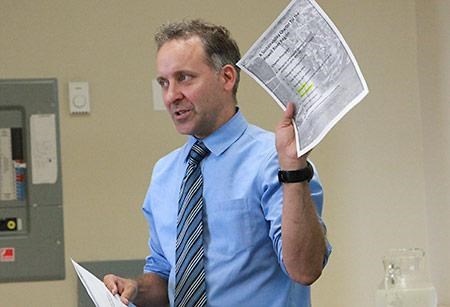Powell River’s primary healthcare providers are taking the pulse of the community to determine how to enhance accessibility in a region where demand outstrips supply.
Guy Chartier, executive director of Powell River Division of Family Practice, spoke to Powell River Regional District’s committee of the whole, Thursday, August 21, to outline the complexities of stretching limited resources. Chartier said the division’s membership includes all of Powell River’s family physicians, nurse practitioners and specialists.
The division has been measuring the delivery of primary health care in Powell River. In 2011, there were 31 family physicians in Powell River, and that number is anticipated to drop to 23 in 2015. Chartier said as of this year, the community is under the average in BC in terms of the coverage and the number of physicians per capita.
“This is a huge game changer in terms of the way we are going to approach the future of health care in the region,” he said.
There are factors that dictate the number of clinic hours available to patients in the Powell River region, he added. From 2011 to 2015, a 27 per cent decrease in clinic hours has been forecast.
“If you put that in terms of unique patients, this means 684 fewer visits per week.”
Chartier said this is creating stress in the delivery of healthcare throughout the region and driving a sense of urgency for the division in developing partnerships, especially with the Powell River Regional District.
Chartier introduced Megan Sloan, coordinator of the Powell River Division of Family Practice, who outlined the A GP for Me program. She said the ministry of health is strongly trying to promote the one-to-one primary care provider-patient relationship. They have provided money to divisions of family practice, such as Powell River’s, to find locally-driven solutions to improve accessibility.
“The overall goal of the program is to confirm and strengthen relationships between physicians and patients, and enable patients without a family doctor to find one. We have some obstacles to overcome to get there,” Sloan said.
“We’ve looked at some of the numbers and our best guess of unattached patients in town is about 20 per cent of the population, or about 4,000 people. We’ve estimated that a third of those are not actively looking for a physician.”
Powell River’s aging population will place significant demands on the health care system. It is estimated that by 2033, 50 per cent of the population here will be over the age of 65. The provincial average of population older than 65 in 2033 is estimated to be about 25 per cent.
“We are looking at about double that number if projections are correct,” she said.
The division will be launching a community survey to find out who has a family doctor, who doesn’t, and what are the strengths and challenges with their relationships and access to the healthcare system. The division is hoping to host a community forum around the issue and focus groups will be formed to gather information.
It has until mid-February 2015 to devise a plan and if deemed successful, the provincial ministry of health will provide more funding for another year to implement it.
Patrick Brabazon, committee chair, asked about the correlation between younger doctors and a reduction in clinic hours. Chartier said the new generation of physicians is like any other group of professionals looking for a different kind of lifestyle.
“You have some retiring physicians that have a Monday to Friday, 9 am to 5 pm practice,” he said. “They retire and the physician taking over is a young mother. So what they do is Monday to Thursday, 9 to 1.”
That doctor will have the same number of patients as the full-time physician but the number of hours of availability is reduced.
“It’s really a generational trend,” he said. “This is the reality of the new generation of physicians.”
Colin Palmer, regional board chair, said he met with the minister of health at the last Union of BC Municipalities convention. Palmer spoke about the number of doctors in the community and the minister said there were 28, but they were not all working full time. Palmer said that is the problem.
Chartier said the responsibilities of rural doctors are different than that of urban ones. Not only are they conducting clinic hours, but they also have hospital visitations and they are also periodically on call in the emergency department.
One of the conversations that is being held is whether there are enough primary care providers to cover requirements. It is a worldwide problem, Chartier said, and in Powell River, it’s critical, so there is a higher level of urgency here.



